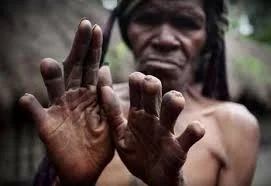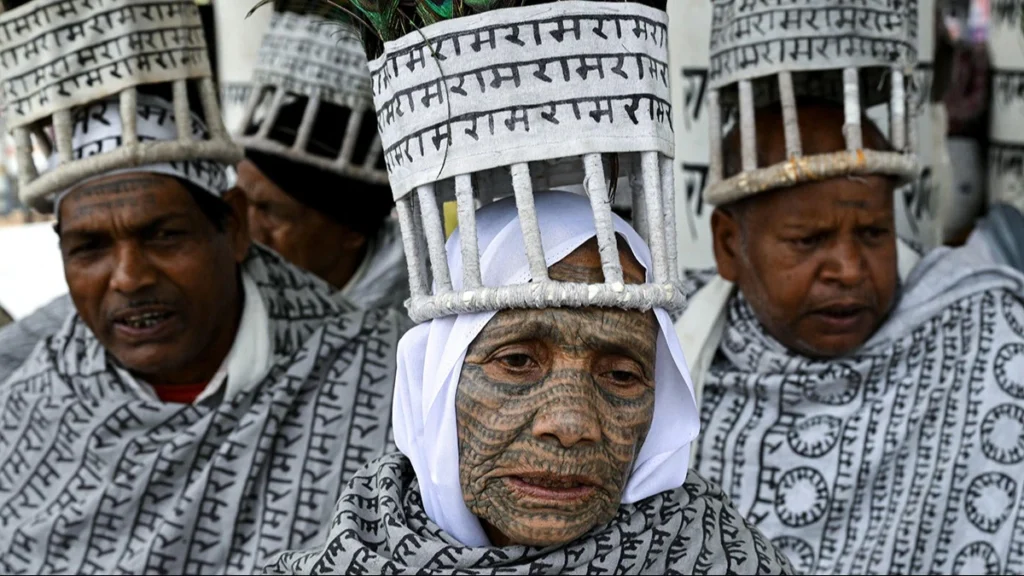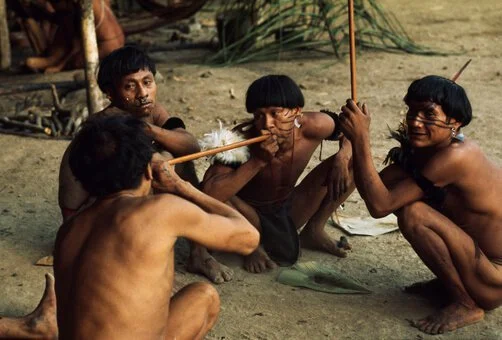Traditions from Around the World: Every culture has its unique customs—some joyful, others somber, and a few downright shocking. These traditions may seem unusual to outsiders, but they often carry deep cultural, spiritual, or symbolic meaning. In this expanded exploration, we’ll take a closer look at 15 fascinating rituals from around the globe, highlighting their significance and the beliefs that keep them alive.
1. Mourning Through Pain: Finger Cutting in Papua New Guinea

In Papua New Guinea’s Dani tribe, grief is not only felt emotionally but also shown physically. When a family member dies, close relatives, especially women, cut off one of their own fingers as a sign of mourning. This act symbolizes the physical pain that matches their emotional suffering. The ritual is also believed to ward off spirits and keep the dead person’s soul from lingering too long. While this practice is rare today, it remains a poignant example of how different cultures cope with loss.
2. The Bullet Ant Glove Ceremony: Proving Strength in Brazil

The Satere-Mawe tribe of Brazil has one of the world’s most painful initiation rites. Young boys must wear gloves filled with bullet ants, whose stings feel like being shot. The boys dance for 10 minutes while enduring this unimaginable pain, showing their bravery and readiness to enter adulthood. The tribe believes this test not only builds character but also connects the individual with the spiritual world, ensuring protection and strength for life’s challenges.
3. Dancing with the Dead: Famadihana in Madagascar

In Madagascar, honoring ancestors takes a lively turn with a ritual called Famadihana, or “turning of the bones.” Every few years, families exhume the bodies of their loved ones, rewrap them in fresh cloth, and celebrate by dancing with the remains. This joyous occasion is a way to show respect, reconnect with the deceased, and seek blessings. It also reinforces the belief that death is not the end but a transition to a new state of existence.
4. Piercing for Purity: Phuket Vegetarian Festival in Thailand

The Phuket Vegetarian Festival is a nine-day event where participants, known as “Ma Song,” undergo extreme piercings of their cheeks, tongues, and other body parts. They believe this self-inflicted pain purifies the soul and brings good fortune. The festival also promotes a vegetarian diet as a way to cleanse the body and mind. The sight of people walking in processions with sharp objects through their faces is both awe-inspiring and a testament to their devotion.
5. Pre-Wedding Blackening Ritual in Scotland

In Scotland, soon-to-be-married couples are subjected to a messy and humorous tradition called “blackening.” Friends and family cover the bride and groom with rotten food, soot, and flour. Once thoroughly “blackened,” the couple is paraded around town. The ritual is meant to prepare them for the challenges of married life, teaching resilience and unity. It’s also seen as a test of how well the couple can handle difficult situations together—a lighthearted yet meaningful way to celebrate.
6. Tattooed Devotion: Ramnami Community in India

In Chhattisgarh, India, the Ramnami community practices a unique form of devotion by tattooing the name “Ram” across their bodies. This tradition began as a peaceful protest against caste discrimination. By marking themselves with the name of Lord Ram, they asserted their belief that devotion should transcend social hierarchies. Even today, this practice is a powerful symbol of faith, equality, and resilience.
7. Baby Jumping Festival: El Colacho in Spain

In the small Spanish village of Castrillo de Murcia, an unusual event called El Colacho takes place. Men dressed as devils leap over rows of babies lying on mattresses. This centuries-old ritual is believed to cleanse the infants of original sin and protect them from evil spirits. While it may look dangerous, the villagers take every precaution to ensure the babies’ safety. The festival is a blend of religious belief and local tradition, attracting visitors from around the world.
8. Lip Plates: A Symbol of Beauty in Ethiopia

Among the Mursi and Surma tribes of Ethiopia, young women wear large lip plates as a sign of beauty and social status. The tradition begins in adolescence, with the lower lip gradually stretched to accommodate larger plates. The size of the plate often reflects a woman’s dowry and desirability. While this practice may seem extreme to outsiders, it is a deeply rooted cultural marker, symbolizing maturity and readiness for marriage.
9. Living with the Dead: Toraja Rituals in Indonesia

In Indonesia’s Toraja region, death is seen as a gradual process. Families often keep the bodies of their deceased loved ones at home for months or even years, treating them as though they are still alive. The dead are given regular meals, fresh clothes, and even cigarettes. This practice continues until the family can afford a lavish funeral, which is believed to help the deceased’s soul reach the afterlife. It’s a touching example of how some cultures maintain bonds with their dead.
10. The Sambia Tribe’s Rite of Passage: Papua New Guinea

In the Sambia tribe of Papua New Guinea, boys undergo a controversial initiation ritual to transition into manhood. This involves consuming the semen of older men, which the tribe believes transfers strength and wisdom. While this practice is rooted in cultural beliefs about masculinity and warriorhood, it is often misunderstood and criticized by outsiders. It highlights how different cultures define and celebrate milestones in life.
11. Scarification for Strength: Kaningara People of Papua New Guinea

The Kaningara people practice scarification as a rite of passage from boyhood to manhood. Young men undergo a series of cuts on their chest and back, designed to resemble crocodile skin. The crocodile is revered as a powerful spiritual creature, and the scars symbolize strength, protection, and maturity. This painful process is a test of endurance and courage, with the scars serving as lifelong reminders of their journey.
12. Tree Burials for Infants: Toraja Tribe in Indonesia

In the Toraja culture, when a baby dies before growing teeth, they are buried inside a tree. A hole is carved into the trunk, and the baby is placed inside, wrapped in cloth. Over time, the tree grows around the child, symbolizing life continuing through nature. This practice reflects the community’s deep respect for life and their belief in the interconnectedness of all living things.
13. Hanging Coffins: Igorot People in the Philippines

For over 2,000 years, the Igorot people of Sagada, Philippines, have practiced the tradition of hanging coffins on cliff sides. The deceased are placed in compact coffins and suspended high above the ground. This unique burial method is believed to bring the dead closer to the heavens. It also protects the bodies from wild animals and flooding. The hanging coffins are a powerful symbol of the community’s spiritual beliefs and respect for their ancestors.
14. Eating the Ashes of the Dead: Yanomami Tribe in the Amazon

The Yanomami people of the Amazon have a ritual where they consume the ashes of their deceased relatives. After cremation, the ashes are mixed with a banana paste and eaten by the community. This practice is believed to keep the spirit of the deceased alive within the tribe, ensuring unity and continuity. It also reflects the Yanomami’s deep respect for their dead and their belief in the cycle of life.
15. Choosing Husbands at a Festival: Wodaabe Tribe in Niger

In the Wodaabe tribe of Niger, women have the freedom to choose their husbands at an annual festival called Gerewol. Men dress in elaborate costumes, paint their faces, and perform dances to attract potential partners. Women judge the men based on their beauty and dancing skills, choosing those they find most appealing. This festival celebrates love, freedom of choice, and the community’s vibrant culture.
You might also like: The Tomatina Festival: A Colorful Celebration of Tomatoes
Traditions from Around the World: Why These Traditions Matter?
While some of these rituals may seem strange or even extreme, they hold deep meaning for the communities that practice them. These traditions:

Strengthen social bonds
Mark important life transitions
Express faith and devotion
Preserve cultural identity
You might also like: 10 Strange Traditions Around the World
Traditions from Around the World: Embracing Cultural Diversity
These traditions remind us of the incredible diversity of human culture. They challenge us to look beyond our own experiences and appreciate the rich tapestry of beliefs, values, and customs that shape the world. By understanding and respecting these practices, we can foster greater empathy and connection across cultures.
Follow our culture page for more such options. Which tradition surprised you the most? Share your thoughts in the comments below! 😊


